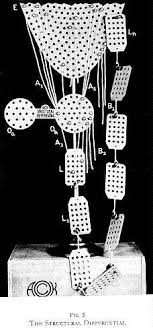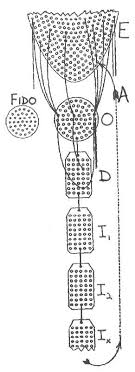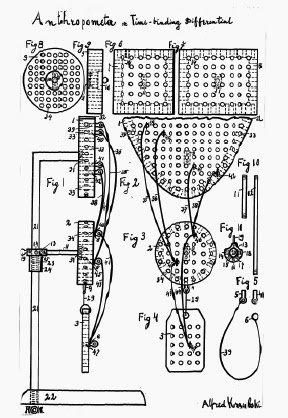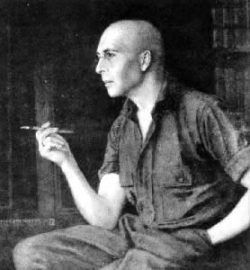Why “The Map is NOT the Territory”

THE STRUCTURAL DIFFERENTIAL (1924)
The inventor of the Structural Differential, Count Alfred Korzybski (1879-1950) was a mathematician and engineer, active in the intellectual life of Warsaw prior to World War One. He was wounded during active service in the Russian army and travelled to America in 1916 where he remained as an independent intellectual. In 1938 he founded the Centre for General Semantics in Chicago.[1]
The Structural Differential is a “plastic diagram” and thought experiment which, in the theory of General Semantics, modelled the relation between an object-event and the human nervous system. The Structural Differential (aka “Anthropometer” or “Time-Binding Differential” ) was first used in a clinical context to help patients diagnosed as schizophrenic apprehend the function of abstracting. The patient would be encouraged to touch the model, and to iterate and re-iterate (in a regimen of Pavlovian self-training) that the thing was not the word it represented. The prevailing theory in the 1920s held that schizophrenia represented a confusion of different levels of attraction(a diagnosis that Bateson agreed with). The Structural Differential is an instrument that affords self-reflexive adaptation. The various stages of the Structural Differential represent different levels of abstraction, the premise being that the human nervous system organises stimulus from the world – in cybernetic terms encodes raw data – and organises it into levels of abstraction. The chain runs from the apprehension of the object-event to higher levels of abstraction.

The letter key accompanying the diagram signifies the following:
E= The state prior to integration is represented by the area E.
This looks like a sieve, with a cerated edge, representing a process which extends into infinity, into the sub atomic universe in flux, frequencies and scales beyond human perception which the human nervous system filters out and orders. This contains things that humans know they do not know and things humans do not know they do not know.
O = the object-event from which the threads extends from the direction of E and in the direction of L,
L= (Label) the first order of abstraction, which is reproduced and augmented into higher levels of abstraction (Ln). These threads back through E in a recursive loop.
This is followed by (feeds through to)[2]
Higher Level Abstractions [3]
In the model, a series of threads (A1) run from E, representing those properties that come together to help humans perceive a particular object-event. These properties are essentially sensorial and within the human spectrum and can therefore be articulated (abstracted–signified).
Like the cyberneticians that followed, Korzybski insisted that the Structural Differential should be made “in the metal” and should be more than a two-dimensional diagram. The Structural Differential should be experienced as an object-event in itself and that the universal possibilities, the specificities of a time and a space, are understood by those contemplating it.
The core concept of Korzybski’s General Semantics is articulated in his first book Manhood of Humanity: The Science and Art of Human Engineering (1921), in which he argued that the uniquely human ability to recognise their place within a hierarchy of abstraction binds human beings to time.[4]
Korzybski takes an approach which may be familiar to readers of Henri Bergson's Creative Evolution.[5] At the first level plants take energy from the sun which they convert into chemical energy; secondly, animals convert organic chemical energy into kinetic energy, which makes animals space-binding; lastly, at the highest level, humans learn to survive through transmitting past experience to each other over generations (which Korzybski calls "human accumulation”), which is the essence of time binding. “The mechanism of the rapid human accumulation is the faculty for higher and higher abstractions, which accelerate its progress at a permanently increasing rate. The term "abstracting" is used here in the "organism-as-a-whole" way, where "senses" and "mind" are not divided; we know that the old elementalistic methods are not valid.”[6]
The concept of time-binding provides an extruded metaphor, stretching over the proposition that “man is like an energy transforming organism” to “man is a time-binder”.[7] For Korzybski, the intervening variable, the medium and binding agent, is language.
Korzybski’s text Time Binding: The General Theory (1924), is structured as a loop: “The beginning presupposes the end and vice verse”[8] Likewise the Structural Differential[9] which is a feature of the text, is structured as a circuit of abstraction which feeds back into itself.
The machine models the fact that “man” is structured by the organisation of levels of abstraction – it is symbolic representation which separates man from object-event. This process is in fact the definition of “man", it distinguishes him from animals, and it is the process which binds “man” to time. In Korzybski’s paper the role of “man”, in its totality, is taken by a representative for human kind, Smith and a representative from the animal kingdom, Fido.
For Fido symbols articulate – the master calls, another dog barks and Fido responds – but Fido lacks cognisance of levels of abstraction. The difference between Fido and Smith is that Fido does not know that he abstracts but Smith does. Korzybski: “The faculty of building higher and higher levels of abstraction is the mechanism of the characteristic rapid accumulation which makes man a man.” [10] Furthermore, this “rapid accumulation” works in cycles, feeding back information which affords adaptation which allows for the next abstraction. The cycling of levels of abstraction is unconscious, an extension of the nervous system and the environment – “senses” and “mind” are not divided. [11]
KORZYBSKI AND MIND
The object-event carries an infinite amount of information – news of innumerable difference. Korzybski provides us with two models:
1) pencil (the object-event) and
2) “pencil” (the symbol which represents pencil)
The content of pencil is inexhaustible, it has infinite characteristics (some of which can be apprehended within the spectrum of human senses). The content of “pencil” on the other hand is fixed by definition. [12]
The object-event itself is something we cannot recognise, but we do recognise an object-event labelled with a word. This is the first level of abstraction, the first integration of an infinite number of characteristics of an event.
Korzybski also warns that we should have “awareness of a circular faculty” which “senses difference and counts differences”. Here we see Korzybski attempt to describe the mechanism of feedback avant cybernetics, the looping which orders the stochastic system. For Korzybski, even the arbitrary introduced within a feedback loop produces pattern.
“We must start somewhere, somehow, anywhere, anyhow, with a set of undefined terms, then go ahead, come back, revise our base (a) for (b), go ahead again, revise our base (b) for (c), go ahead again, and so on endlessly. Human knowledge is inexhaustible. No set is undefined absolutely, but only relatively so.”[13]
It is not hard for us to take this process as a description of Bateson’s ontology of difference. Furthermore, this cycling, sorting and organisation of information is non-conscious, it is derived, in a manner described by Samuel Butler in Evolution Old and New, as involuntary functions emerge into consciousness. The process also speaks to Lacan’s understanding of the unconscious as a machine which sorts and organises as impulses cycle into syntactic patterns, and then into conscious thought.

KORZYBSKI AND BATESON
There are points in Korzybski’s paper which could be cut and pasted into a work by Bateson without creating too much of a disturbance. For instance, this section from Time Binding:
“If we confuse the orders of abstractions; if we fancy that the high abstractions are first-order abstractions, which they are not, then we get ‘absolute matter,’ ‘absolute space,’ and ‘absolute time.’ If the world is made up of ‘absolute matter,’ ‘absolute space,’ ‘absolute time’ then of course such a structure cannot account for ‘mind’ and what not. The number of possibilities in such a universe are too limited, etc., etc., and all the rest follows. But if the world is made up of ‘quanta,’ ‘fields,’ etc., then all we see, we feel, we know and can know are averages, summaries, abstractions of different orders, etc., etc. Only a language of processes, transformations, variables, functions, integration, abstractions of different orders, probabilities, etc., etc., can account for such a universe. Mathematics considered as an activity of the human organism, reflects in its structure and form the structure and form of the universe.”[14]
Here Korzybski argues (as Bateson will) that it is a confusion of orders of abstraction which preclude the conception of mind as coextensive with system. It is such a confusion (the “objectification of high abstraction”) that reinforces the false division between environment and organism and obscures the reality that such a division is arbitrary. Furthermore, this time-binding practice is a process of encoding: Korzybski argues that the orders of abstraction that bind humans to time are stochastic, units of probability, they are “averages, transformations, variables” … “summaries, abstractions of different orders”.
For Bateson however: “The bridge between the territory and the map is difference. It is only news of difference that can get from the territory to the map, and this fact is the basic epistemological statement about the relationship between all reality out there and all perception in here: that the bridge must always be in the form of difference.”[15] In the cybernetics of Korzybski and Bateson "the difference that makes a difference" lies between the physical and the conceptual, "where both can be seen to meet the notion of information."[16]
The new insights brought by communication theory and cybernetics allowed Bateson to affirm the central tenet of General Semantics. Neither the map nor the territory are the key thing, what matters is the relation between map and territory – the interface between the physical and the conceptual is in ratio of difference. The model of the map and territory becomes isomorphic (homologic) with the cybernetic explanation: “The subject matter of cybernetics is not events and objects but information carried by events and objects” Bateson argues.[17] In Bateson this space of difference becomes the “screen of consciousness”, the interface between map and territory. This articulation of Korzybski’s idea would extend, via Bateson, into the media ecology of the Radical Software group.[18]

KORZYBSKI – BATESON – THE DIFFERENCE THAT MAKES A DIFFERENCE
Alfred Korzybski and Gregory Bateson’s careers bear striking similarities.
Korzybski and Bateson each developed theories of communication predicated on Russell-Whitehead’s theory of abstraction.[19] Bateson adapted the term “the map is not the territory” to illustrate his own theory of communication and ecology. Both Korzybski and Bateson held that the distortions arising from category confusion was at the root of a general epistemological crisis; both Korzybski and Bateson developed their respective theories to a mature state whilst working in mental institutions alongside schizophrenics: Bateson at the University of California Medical School and Palo-Alto Veteran’s Hospital, California; Korzybski at St. Elizabeth’s Hospital, Washington D.C. Their respective theories of schizophrenia (Bateson’s double-bind theory and Korzybski’s semantic analysis) diagnosed the condition as a regressive psychosis. Korzybski was not alone in developing this approach in the early 1920s, others included the psychiatrists at St. Elizabeth’s Dr. William Alanson White and Dr. Henry Stack Sullivan, who worked alongside Korzybski developing a theory of schizophrenia which was distinct from the Freudian approach.[20]
Both Bateson and Korzybski developed their systems in more generalised terms; positing recursive systems in which the human subject as co-extensive with the environment and in which the line between organism and environment is arbitrary. Both understood the space between the map and the territory as the space of difference – the generative space between the physical and the conceptual.[21] For Gregory Bateson, the revolution in Cybernetics allowed a re-articulation of the issues that had concerned him earlier on in his thinking. Wiener, a student of Russell’s, along with other key cyberneticians and experimental psychologists, drew on Russell-Whitehead’s theory of abstraction to articulate hierarchies of order within negentropic, stochastic systems.[22]
Korzybski, working a generation earlier, drew on his own contemporaneous sources, such as the logical positivists of the Vienna Circle (which had close ties to Warsaw during Korzybski’s formative years), and the “engineering millennialism” of Henry L. Gantt, which informed the “social engineering” element in Manhood of Humanity. Later, as Korzybski moved toward Science and Society (1933) and the fully developed system of General Semantics, he incorporated the Pavlovian behaviourism of stimulus and response. These all informed the methods used with the Structural Differential during treatment of psychiatric patients at St. Elizabeth’s hospital.
Both Bateson and Korzybski drew on new ideas which served to articulate well-established theories which already had the order of abstraction as the central organising principle at their foundation.[23]
- ↑ Paulson, Ross E. Language, Science, and Action: Korzybski's General Semantics : a Study in Comparative Intellectual History. Praeger Pub Text, 1983.
- ↑ Korzybski, Alfred. Time-binding: The General Theory : Two Papers 1924-1926. 1949. p. 17
- ↑ I take this illustration from Science and Sanity, at which point the Anthropometre had acquired the name Structural Differential. Korzybski, Alfred. Science and Sanity: An Introduction to Non-Aristotelian Systems and General Semantics. Institute of GS, 1958.
- ↑ Korzybski, Alfred. Manhood of Humanity: The Science and Art of Human Engineering. 1921.
- ↑ For a reading of Bergson's Creative Evolution see Vibrations
- ↑ Korzybski, Alfred. Time-binding: The General Theory : Two Papers 1924-1926. 1949. p 10
- ↑ Paulson, Ross E. Language, Science, and Action: Korzybski's General Semantics : a Study in Comparative Intellectual History. Praeger Pub Text, 1983. p. 28
- ↑ Korzybski, Alfred. Time-binding: The General Theory : Two Papers 1924-1926. 1949.
- ↑ Referred to as the Anthrometer in Korzybski’s Time Binding For the sake of clarity, I take this model from Science and Sanity (p.398) Korzybski, Alfred. Science and Sanity: An Introduction to Non-Aristotelian Systems and General Semantics. Institute of GS, 1958.
- ↑ Korzybski, Alfred. Time-binding: The General Theory : Two Papers 1924-1926. 1949.
- ↑ To support this conception Korzybski would argue that a human being thinks as much with their big toe as with their brain. Korzybski, cited in Morgan, Ted. Literary Outlaw: The Life and Times of William S. Burroughs. New York: W. W. Norton & Company, 2012. P.77
- ↑ Korzybski, Alfred. Time-binding: The General Theory : Two Papers 1924-1926. 1949. p11
- ↑ Korzybski, Alfred. Time-binding: The General Theory : Two Papers 1924-1926. 1949. p20
- ↑ Korzybski, Alfred. Time-binding: The General Theory : Two Papers 1924-1926. 1949.p.22
- ↑ Bateson, Gregory, Afterward, in Brockman, John. About Bateson: Essays on Gregory Bateson. Plume, 1977. P.240
- ↑ Therry Bardini, Bootstrapping, Douglas Engelbart, Coevolution, and the origins of the personal Computer, Stanford, 2000, p. 53
- ↑ Bateson, The Cybernetic Explanation, 1967, in Bateson, Gregory. Steps to an Ecology of Mind: Collected Essays in Anthropology, Psychiatry, Evolution, and Epistemology. Chicago: University of Chicago Press, 2000. p. 407
- ↑ … and through to the human enhancement research projects of Douglas Engelbart… and on into self-improvement sect EST (for whom Bateson lectured and for whom a number of Engelbart’s researchers were members, see Thierry Bardini, Bootstrapping, Douglas Engelbart, Coevolution, and the Origins of Personal Computing, Stanford, 2000]. This notion also influenced the architectural vision of ant farm, who understood the space of architecture as an interface which enhanced and mediated human experience rather than exclusively the space of habitation or shelter [see: Antfarm, Allegorical Timewarp]
- ↑ Whitehead, Alfred N., and Bertrand Russell. Principia Mathematica . Cambridge: Cambridge University Press, 1997. (1910 [1925])
- ↑ Paulson, Ross E. Language, Science, and Action: Korzybski's General Semantics : a Study in Comparative Intellectual History. Praeger Pub Text, 1983. p 57
- ↑ Bardini, Thierry. Bootstrapping: Douglas Engelbart, Coevolution, and the Origins of Personal Computing. Redwood City: Stanford University Press, 2000. p53
- ↑ Indeed the theory was a central plank of Anglo-American intellectual discourse after world war one, influencing, amongst others, Ogden and Richards’ semantic (Meaning of Meaning); the emergent clinical psychology theories of Dr. William Alanson White and Dr, Henry Stack Sullivan. See: William Alanson White: The Washington Years, 1903-1937 : the Contributions to Psychiatry, Psychoanalysis, and Mental Health by Dr. White While Superintendent of Saint Elizabeths Hospital. 1976; White, William A. Outlines of Psychiatry. 1911.
- ↑ The philosopher and cybernetician A. S. C. Northrup argued that Korzybski had constructed a ‘hygienic’ system rather than a theory. All the elements within General Semantics were self-referential – what can be said about the system could be said only in terms established by the system itself. He argued that General Semantics, as a system, was a therapy (see Evans Paulson)